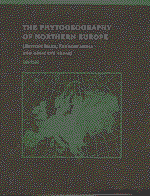Book contents
- Frontmatter
- Contents
- Preface
- Acknowledgements
- 1 Introduction
- 2 Climate
- 3 Edaphic factors
- 4 The geological history of the present European flora
- 5 The atlantic and oceanic elements
- 6 The thermophilic element
- 7 The boreal element
- 8 The arctic, alpine and montane elements
- 9 Endemic, disjunct and centric distribution patterns
- 10 Anthropochorous plants
- Appendix I Calculation of climatic parameters for comparison with plant distributional data
- Appendix II The Northern European species of Flora Europaea with indications of their status and climatic correlations
- Appendix III Arctic species of vascular plants
- Appendix IV Endemic species of vascular plants, bryophytes and lichens
- Appendix V Extra-European disjunctions – bryophytes and lichens
- References
- Index
Appendix I - Calculation of climatic parameters for comparison with plant distributional data
Published online by Cambridge University Press: 23 October 2009
- Frontmatter
- Contents
- Preface
- Acknowledgements
- 1 Introduction
- 2 Climate
- 3 Edaphic factors
- 4 The geological history of the present European flora
- 5 The atlantic and oceanic elements
- 6 The thermophilic element
- 7 The boreal element
- 8 The arctic, alpine and montane elements
- 9 Endemic, disjunct and centric distribution patterns
- 10 Anthropochorous plants
- Appendix I Calculation of climatic parameters for comparison with plant distributional data
- Appendix II The Northern European species of Flora Europaea with indications of their status and climatic correlations
- Appendix III Arctic species of vascular plants
- Appendix IV Endemic species of vascular plants, bryophytes and lichens
- Appendix V Extra-European disjunctions – bryophytes and lichens
- References
- Index
Summary
Several climatic parameters have been calculated for each of the the 50 × 50 km grid squares of Atlas Florae Europaeae (O. Skre, unpublished data). The main source of the primary meteorological information is Anonymous (1973). In some instances where this is insufficient, for instance for Svalbard, information has been taken from other sources. The highest or lowest altitudes for each of the squares have been taken from national atlases. They are considered to be accurate to within about 10 m.
The following parameters have been used as a basis for the comparative maps (Figs. 12–17, 30–38, 42–50 and 54–63).
Winter temperatures (for comparisons with the atlantic and the boreal distribution patterns)
This is the mean temperature of the coldest month for each station. One problem is that in oceanic regions February is the coldest month, whereas in continental stations it is January, and in intermediate areas it is either January or February. To overcome this, we have used the normals of the 5 coldest months at each station. By means of least-square methods a parabola was fitted to the observations. The mean temperature of the coldest month is then the minimum of the parabola. It is always near the temperature of the coldest month.
By comparison with records from neighbouring stations at different altitudes, it is evident that the altitudinal temperature gradient differs as a function of continentality. In Portugal the gradient is about 0.6°C per 100 m altitudinal difference, whereas in northern Russia it is zero.
- Type
- Chapter
- Information
- The Phytogeography of Northern EuropeBritish Isles, Fennoscandia, and Adjacent Areas, pp. 157 - 161Publisher: Cambridge University PressPrint publication year: 1998



